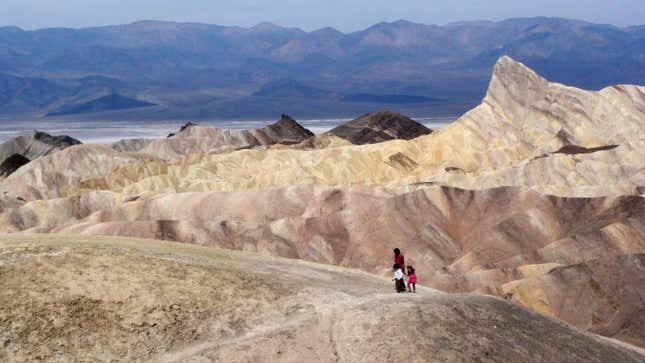
California had itself a weekend of rolling blackouts, freak thunderstorms, and a fire-induced tornado. But the state had to go and do one more wild thing: set the record for hottest temperature recorded anywhere on Earth.
Death Valley hit 130 degrees Fahrenheit (54.4 degrees Celsius) on Sunday. The data still has to be confirmed, but if it is, this past Sunday will have been our planet’s hottest reliably recorded day ever.
The heat wave gripping California is a brutal one. A ridge of high pressure has created abnormally hot conditions across nearly the entire state. That’s usually a recipe for rare temperatures in Death Valley, a national park that also happens to be one of the hottest places on Earth. Earlier this summer during a similar setup, the mercury there topped out at 128 degrees Fahrenheit (53.3 degrees Celsius) in what was then the hottest temperature on Earth for the year. But because it’s 2020, things had to get worse.
The 130 degrees Fahrenheit reading will be examined by a team of experts to determine its validity. That team involves the National Climate Extremes Committee, which is part of the U.S. National Oceanic and Atmospheric Administration. The World Meteorological Organization will also examine it.
“Our evaluations are very detailed and consequently somewhat time-consuming,” Randall Cerveny, a climate expert at Arizona State University and WMO rapporteur of weather and climate extremes, said in an email. “It may take upwards of six to nine months to finish. The key is that we do it right; in the 13 years of operation, never has one of our official WMO evaluations been overturned, a testament to the high-quality and rigorous evaluation process handled by some of the top atmospheric scientists in the world.”
What they’ll be examining, though, is whether this is officially the hottest August temperature ever recorded. That’s because the official hottest temperature on Earth is a reading also from Death Valley from July 10, 1913, when the temperature rose to 134 degrees Fahrenheit (56.7 degrees Celsius). If you would like to start a slap fight between meteorologist, bring up the 1913 temperature. The accuracy of the reading is (ahem) hotly disputed due to a number of factors, including its inconsistency with other readings across the region that day. The 134-degree-Fahrenheit reading is accepted as official, though, by both WMO and NOAA.
Deke Arndt, the director of the Center for Climate Weather at NOAA’s National Centers for Environmental Information, said that it’s possible the National Climate Extremes Committee could re-examine the 134 degree Fahrenheit record. As the former head of the committee, Arndt said he “wasn’t keen to reopen it,” but the new head “may wish to revisit it, and I would of course support their findings.”
For now, though, Sunday’s temperature has a shot at the reliably measured record as well as all-time planet high for August, but a few degrees short of the official all-time high. Is this some real nerd shit? Yes. Am I here for it? Also yes.
Regardless, I think we can all agree 130 degrees Fahrenheit is pretty abnormal, even for the hottest place on Earth! It comes in what is shaping up to be one of the top two hottest years on record where heat records have fallen from Siberia to Iraq to large swaths of the U.S. Heat is, of course, one of hallmarks of global warming.
While the sparsely populated nature of Death Valley makes it easy to marvel at the heat record from this weekend, more populated parts of California have also been dealing with unbearable heat. The state capital of Sacramento hit 114 degrees Fahrenheit (45.6 degrees Celsius) on Sunday. In addition, the entire Bay Area was under a thunderstorm watch. While that may sound totally normal to anyone east of the Mississippi where summer storms are common, this is California’s dry season. Summer rain is rare, let alone storms humid enough to produce lightning. But in addition to the ridge locking in the heat, winds have also blown tropical moisture courtesy of the remnants of Hurricane Elida that formed over the Pacific last week.
A friend in Santa Cruz told me they saw lightning “like we’ve never seen around here” on Saturday. And stunning images captured on Saturday show lightning over the ocean and a bizarre roll cloud, the likes of which preceded last week’s Midwest derecho, zipping into Santa Cruz.
The lightning has also sparked numerous fires across the state, including the Loyalton Fire that sent a towering firenado into the sky. Oh, and the state has been dealing with rolling blackouts to deal with the massive strain the heat has put on the grid. The worst part of all this is knowing things will get much, much worse as the climate crisis intensifies. So, uh, we should probably do something about that.
Update, 8/17/20, 5:50 p.m.: Comments from Randall Cerveny have been added to this post.